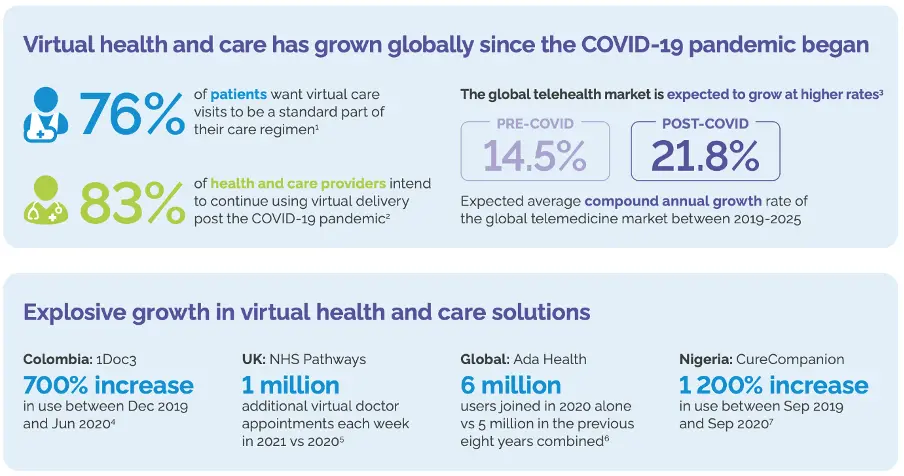The Broadband Landscape: The New Normal
State of Broadband 2022
This chapter provides an overview of the latest trends in digital connectivity, including access, adoption and use in the new post-pandemic world. COVID-19 is arguably the biggest event to ever impact the nature of broadband with implications for speeds, data usage and affordability. The pandemic sharply magnified the consequences of the digital divide by concretely demonstrating how millions of people without broadband could not access public services or learn from home. The chapter highlights how the pandemic has accelerated the uptake of broadband and the adoption of digital services by individuals and businesses, the digitalization of governmental services and more services moving online. It explores how much this will be sustained post-pandemic and what the consequences are for the design and quality of broadband networks. The chapter also considers some of the challenges resulting from COVID-19.
Pandemic induced take-up of online activities
Quarantine measures due to COVID-19 resulted in an acceleration in the adoption of digital services and broadband infrastructure. With the COVID-19 pandemic, broadband—for those who had it—became a vital necessity for working, learning, accessing basic services and keeping in touch.
The latest ITU data show that uptake of the Internet accelerated during the pandemic. In 2019, 54 per cent of the world’s population were using the Internet with this figure growing to an estimated 66 per cent in 2022, representing 5.3 billion people. In 2020, the first year of the pandemic, the number of Internet users grew by over 10 per cent, the largest increase in a decade; in LMICs Internet use went up 15 per cent. A significant part of this growth was driven by the need to use quarantine-related applications such as videoconferencing for work and education as well as online shopping, access to public services and remote health consultation.
Work from home
It is estimated that over 550 million people around the world were working from home in the second quarter of 2020—equivalent to over 17 per cent of the global workforce—due to lockdown measures related to the pandemic. Findings also suggest that the potential to work from home is linked to country income level.
Work from home triggered a large increase in videoconferencing. While there are no precise figures on the number of individuals who use videoconferencing for work, available data suggest it is in the hundreds of millions and increased sharply as a result of the pandemic (bearing in mind that many people use more than one videoconferencing package). In October 2020, Microsoft Teams had more than 115 million daily active users, Zoom had 300 million daily meeting participants, Google around 100 million participants and Cisco’s Webex almost 600 million participants during the month of September 2020.
The shift to working from home has had an impact on broadband connectivity. This includes greater uploading from videoconferencing, a shift in network peak times to daytime from the evening, increased demand for faster speeds and higher data consumption.
Remote learning
The pandemic forced millions of students to learn from home. According to the United Nations Children’s Fund (UNICEF), there were school closures in 188 countries as of April 2020 with around 90 per cent introducing digital or broadcast remote learning. Latin America was the worst affected with the region’s students missing an average of 170 days of school, over four times the world average.
Share of countries that implemented digital and broadcast remote learning policies, by education level

Note: Figures are estimated using simple averages across countries.
Source: UNICEF.
Measures taken by governments to enable remote learning reached around 70 per cent of school children from pre-primary to secondary education. Over 80 per cent of countries introduced online learning during school closures, reaching around a quarter of school children around the world—or more than 350 million primary and secondary school students.
Virtual health and care
While telemedicine has been discussed as a breakthrough technology for over two decades, until COVID-19, growth has been slow. A group of medical researchers remark “a crisis provides an opportunity” with quarantine restrictions combined with advances in digital technology (e.g. Internet of Things (IoT) with next-generation 5G networks, artificial intelligence (AI) that uses deep learning, big data analytics, and blockchain and robotic technology) providing the perfect environment for telemedicine to progress. A recent report from the Broadband Commission’s Working Group on Virtual Health and Care found that the pandemic triggered a giant uptake in virtual health and care services. In the US, the share of telehealth claims was 25 times greater in January 2022 compared to October 2019. In India the number of consultations on the e-Sanjeevani health platform was four times higher in February 2022 compared to October 2020. In Argentina there was a 230 per cent increase in telemedicine calls after the onset of COVID-19.
Growth in virtual health and care since the COVID-19 pandemic
 Source: Broadband Commission Working Group Report on Virtual Health and Care, 2022.
Source: Broadband Commission Working Group Report on Virtual Health and Care, 2022.
Disclaimer: This interactive report is an abridged version. To read the full text, download the full report here.

